Memo to the ABC news readers:
Is coronate a real word?
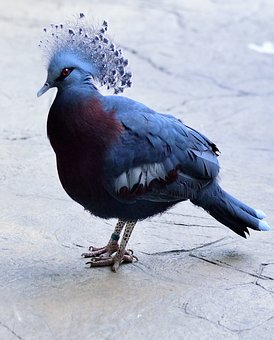
It is actually a word and has been since the 17th century. However, its usage has been confined to flora and fauna – and as an adjective, not a verb. So, a bird may have a plumage “coronate with blue feathers”.
Just look up your friendly Wikipedia. The genus Carolus Rex Britannicus was crowned, and coronate in plumage spectral.
Lowe Zest
I am not a banker nor intimate with the obstacle course which seems to present itself to those who desire to be our Reserve Bank Governor. Philip Lowe always seemed to be a furtive mouse who had inherited his job by being a diligent bureaucrat who had spent his working life in the Reserve Bank.
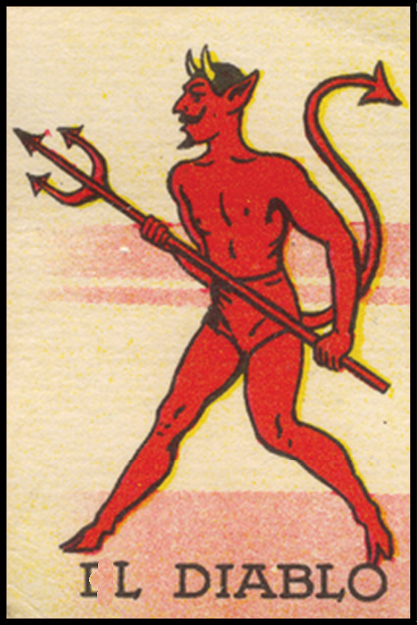
From childhood I knew the Governor of the Reserve Bank was important because his signature appears on bank notes and he was the person to whom the population should genuflect as he was the Keeper of the Vault. Like Roman Catholic cardinals, the governorship has been confined to males. Then Philip, with his furtive smugness at a time when it was de rigeur to nurture zero inflation, made a fatal prediction about the reappearance of il diablo di inflazione. Unlike the Dan Brown hero, Robert Langdon, his statement that il diablo was not to appear until 2024 was absurdly wrong. It had re-appeared two years earlier and from then on, as the house mortgage flames started to consume the population, confidence in his judgement and the Reserve Bank in general sank. This has made his position untenable. But the Mouse continued to roar – not so much roar but to explain to anybody who would listen that he should be re-appointed at the end of his seven-year term which finishes this coming September, presumably for another seven years.
Yet his whole bespoke body language emits an eroded self-confidence behind his wan smile and glittering eyes. In all, he is a creature of poor communication skills. Contrast that with the urbane behaviour of the Deputy Prime Minister when he is obviously peddling even more arrant nonsense but does have the relaxed benevolent communication skills of the oleaginous snake charmer. Tragic that should be true as seems to be the case.
Instead of making it clear that Mr Lowe should have been given an emeritus role in advising on the problems of monetary policy in Macquarie Island, the Government brought in a review of the Reserve Bank. It would be surprising if you employ, as the Government has done, a person with a stake in the Canadian and UK way of doing such things, that she would not recommend a similar system, even if it has apparently not worked well there. Irrespective of the validity of that position, it would be tragic to replace a personality who failed in a crisis with an overseas system which has not done any better. Introducing a range of part-time economists into a revised Board would seem to unnecessarily diffuse responsibility. Even if the decisions are made public, the actual names of how the Board voted would remain undisclosed.
I thus believe it is timely that a former Chairman of the Board, Ian Macfarlane, in a salutary article in the Australian Financial Review said: “I must also intrude a personal note at this stage. When looking back on my career, at least 80 per cent of my knowledge base was the result of on-the-job learning.
Many other people in senior positions have reported the same experience. But the proposed external experts, who are already handicapped by being part time, will also have no on-the-job training.
The final twist is that after five years on the committee, by which time they will have had some valuable on-the-job training, they will have to leave and be replaced by a novice.”
Putting Macfarlane into context was that he served in the Reserve Bank from 1979 onwards. He was the Governor of the Reserve Bank for ten years between 1996 and 2006 and was praised as one of the best Governors the bank has had, given that he had several critical periods in the economic fortunes of the nation to navigate. The fact that he was compelled now to write in defence of the current system, where not only power but also responsibility is very identifiable, why change the system because for a few months on Australia has somebody in the role who has palpably failed. Single point accountability in the ability of the Governor makes failure very obvious, as does success.
As soon as the Budget is bedded down, the Government should announce the name of the new Governor, looking first for the best we have in the Reserve Bank but then also canvassing talent elsewhere. In assessing suitability, it is important to learn from the experience of promoting someone who, even 40 years ago when he was a young man, was perceived as having very limited communication skills, even if he was very intelligent, with an appetite for work. It is significant to note that Lowe, unlike Macfarlane, has never worked outside the Bank.
But there is one last point which Ross Gittins has injected into the discussion of the future – that of a dedicated monetarist being appointed to the Governorship. He refers to the review of the Reserve Bank: While rightly criticising the Reserve for encouraging groupthink, the report is itself a giant case of groupthink. It accepts unquestioningly the conventional wisdom of recent decades that there’s really only one way you could possibly manage the economy through the ups and downs of the business cycle, and that’s by manipulating interest rates.
Gittens sarcastically dismisses that currency manipulations are the only way to regulate the economy; and the Review Committee being full of the same were also guilty of groupthink. He goes on to reveal his Keynesian bent by adding: Any role for “fiscal policy” – changing taxes and government spending? Didn’t think of that but, no, not really. Just make sure it doesn’t get in the way of the central bank. Apparently, slowing the growth in spending by directly punishing the small proportion of households young and foolish enough to load themselves up with mortgage debt is “best practice”.
Treasurer Chalmers be careful what you wish for?
We’ll know if the Wheel caused that Weal!
One of the most difficult words for those who grew up with the “th” sound is to pronounce it correctly. Even the Irish, who used to have the “th” sound in Old Irish, now don’t bother and listening to the lilting Hiberno-English, the “th” has been contracted to only a “t”.
This leaves another sound and that is the pronunciation of “wh”. If those learning English get used to the few words where the “w” disappears as in “who” and all its different forms of case and “whole”, then how do you pronounce “wh” as different from just plain “w”.
Some would say there is no difference because usage is superseded by the sense, the meaning. Take “Whether” and “Weather”. The syntax would give the sense, as much as the sound.
However, take confronting two women of similar appearance. One conceivably could turn to your companion and say “Which is which?”; but although unlikely you may be asking “Which is witch?”
I remember there were teachers in my youth who taught us to say “wh” is though we were blowing; and I always remember the Masefield poem “Sea Fever”, and the phrase “the wind like a whetted knife” and being encouraged to blow “whetted” not “wetted’ – because the “wh” simulated the sound of the wind blowing.
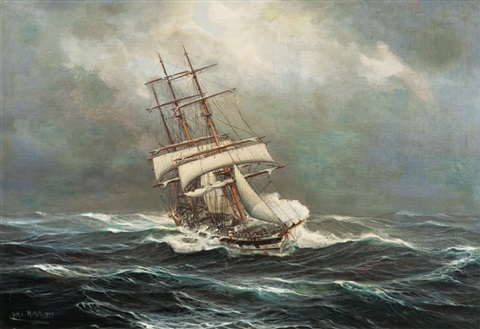 Listening to John Masefield, even though he was very elderly at the time, reciting his poem “Sea Fever”, there may be some who say that Masefield gently acknowledged the difference between the two, as there are both words with “wh” and “w” in the poem. Yet his pronunciation is hardly convincing if one is trying to discern a difference in pronunciation.
Listening to John Masefield, even though he was very elderly at the time, reciting his poem “Sea Fever”, there may be some who say that Masefield gently acknowledged the difference between the two, as there are both words with “wh” and “w” in the poem. Yet his pronunciation is hardly convincing if one is trying to discern a difference in pronunciation.
Therefore, on the basis that “whetted” could have been considered as truly onomatopoetic but not obviously so by even the author, I’m afraid I must conclude that “whither” has indeed withered.
Kachinas
The first time I came to the Southwest was in 1976 to visit my brother Tony, who had bought a ranch, where he lived, in Española, New Mexico. Even though Tony was the younger one, he led the way, as always; he loved this land first. When asked Tony used to say that he liked to live in New Mexico because with the mesas being so high they made the heavens nearer and he felt closer to God. Dedication by Barton Wright in his book “Classic Hopi and Zuni Kachina Figures”
We go through periods when we fall in love with locations and when we do, we tend to accumulate several objects to remind us of the place. One of these is a modest collection of 14 kachina figurines, the work of the Hopi tribes in the American South-west. The Zuni, a companion tribe, created similar figures but they were harder to come by as we found to be the case.
Taos is the township where much of my love of this area is centred. I first went to Taos in 1982 but have been back since. Taos is a couple of thousand metres above sea level, and in these spare mountains is where Taos has remained since its foundation in the early seventeenth century. I think it is where I first saw kachinas and my fondness for Taos will always remain. One can collect kachinas and yet never get close to obtaining every different one.
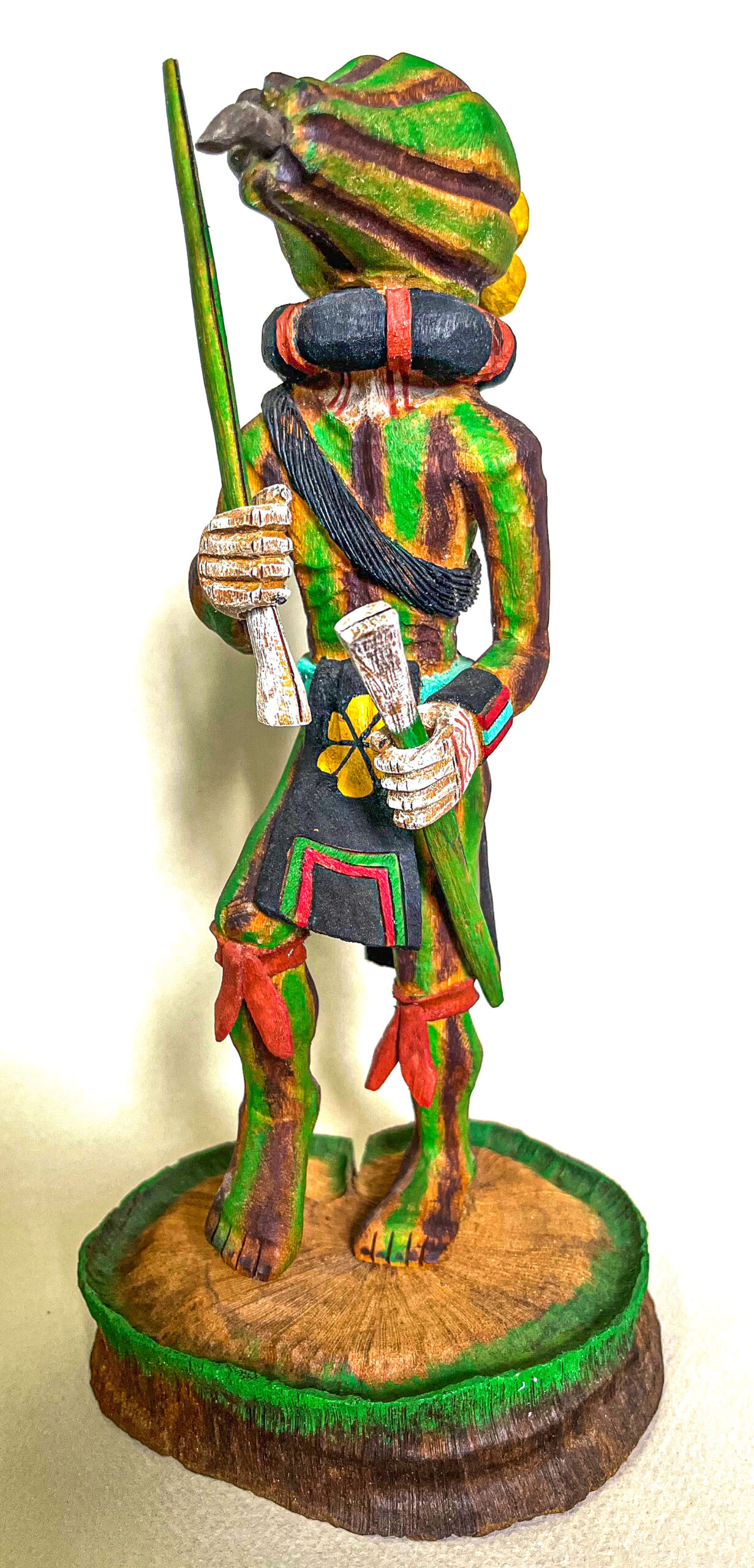 I have always wanted the one called Melonhead, and I saw one in a store in Taos. I prevaricated and after thinking overnight about purchasing, I decide to buy it. The store did not open, belying the sign on the door. Bugger! We had to leave as we had to get back to Santa Fe. Some years later, we purchased one on eBay – a Melonhead. When it arrived, it was not the best carved example, and certainly not of the same standard as the one we left behind, but it was colourful and adequate. Anyway, we love it.
I have always wanted the one called Melonhead, and I saw one in a store in Taos. I prevaricated and after thinking overnight about purchasing, I decide to buy it. The store did not open, belying the sign on the door. Bugger! We had to leave as we had to get back to Santa Fe. Some years later, we purchased one on eBay – a Melonhead. When it arrived, it was not the best carved example, and certainly not of the same standard as the one we left behind, but it was colourful and adequate. Anyway, we love it.
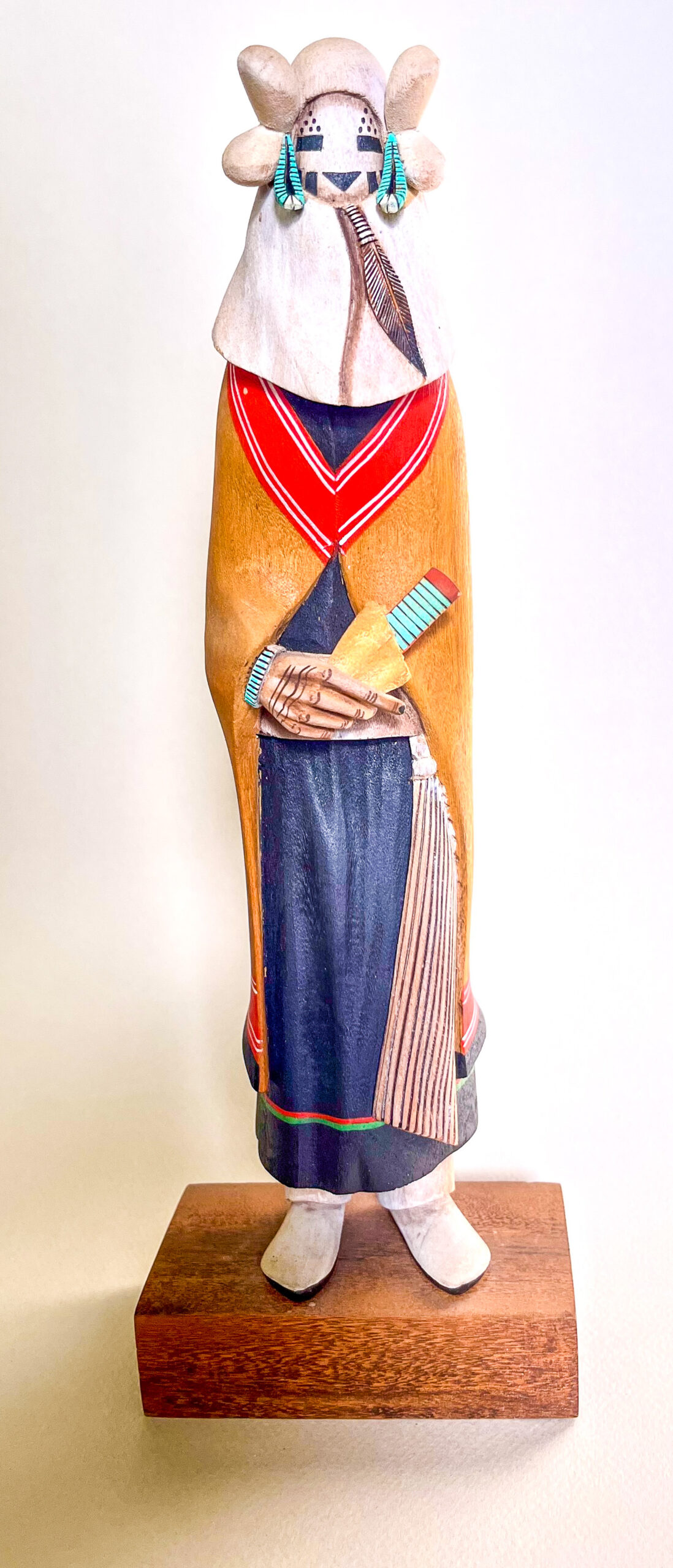 My other favourite is the Snow Maiden, which is a demure, simple, yet captivating figure which, unlike so many kachinas, has a recognisable human visage, because these dolls are the acme of a people who expressed their animism in the form of these cottonwood figurines. The carving exhibits varying degrees of complexity, but it is an art of carvers with some inherent quasi-religious licence.
My other favourite is the Snow Maiden, which is a demure, simple, yet captivating figure which, unlike so many kachinas, has a recognisable human visage, because these dolls are the acme of a people who expressed their animism in the form of these cottonwood figurines. The carving exhibits varying degrees of complexity, but it is an art of carvers with some inherent quasi-religious licence.
The Hopi’s driving force has always been the ongoing need for water and its importance is reflected in the complex rituals designed by the Hopi to invoke the supernatural in assuring water for consumption and for farming in what is an arid area.
As the author of Hopi Kachinas has written, when the rain clouds drift over the villages, it is the rain-bringing kachinas who are there.
“The clouds hide not only the faces of the Hopi’s departed ancestors who, taking pity on their grandchildren, are bringing them rain, but an almost infinite variety of kachinas who have other functions beside rain bringing.”
The clouds are representations of an intangible world, akin to heaven. The human race always seems to look upwards for spiritual inspiration and having to interpret the celestial nuances in a material form. For the Aboriginal people in Northern Australia, the Wandjina fulfils this function; for the Hopis it is the kachina.
The Hopis go further, dressing as kachinas and performing rituals commencing in December and ending in July. In December, it is a matter of releasing the kachina spirits from the underworld, as depicted by chambers called kivas which exist below the Hopi villages. The dancing rituals continue until mid-summer, when the men are required for the practical task of harvesting the crops which have grown under the benison of the kachina spirit. It is these which are interpreted through the figures.
Kachinas are a polyglot world of figurines and the carved cottonwood interpretation has the charm not only reflecting the Hopi skills but also the imaginative interpretations. When you want to purchase one you are confronted with the mythology of having continuity in the carving from one piece of wood, with all the intricacies involved. Some, like our Snow Maiden, may have been carved in one piece, but some of the others, with all the frills, could not conceivably be done as a single piece. This does not detract from the intricacies of many, often reflected in the price.
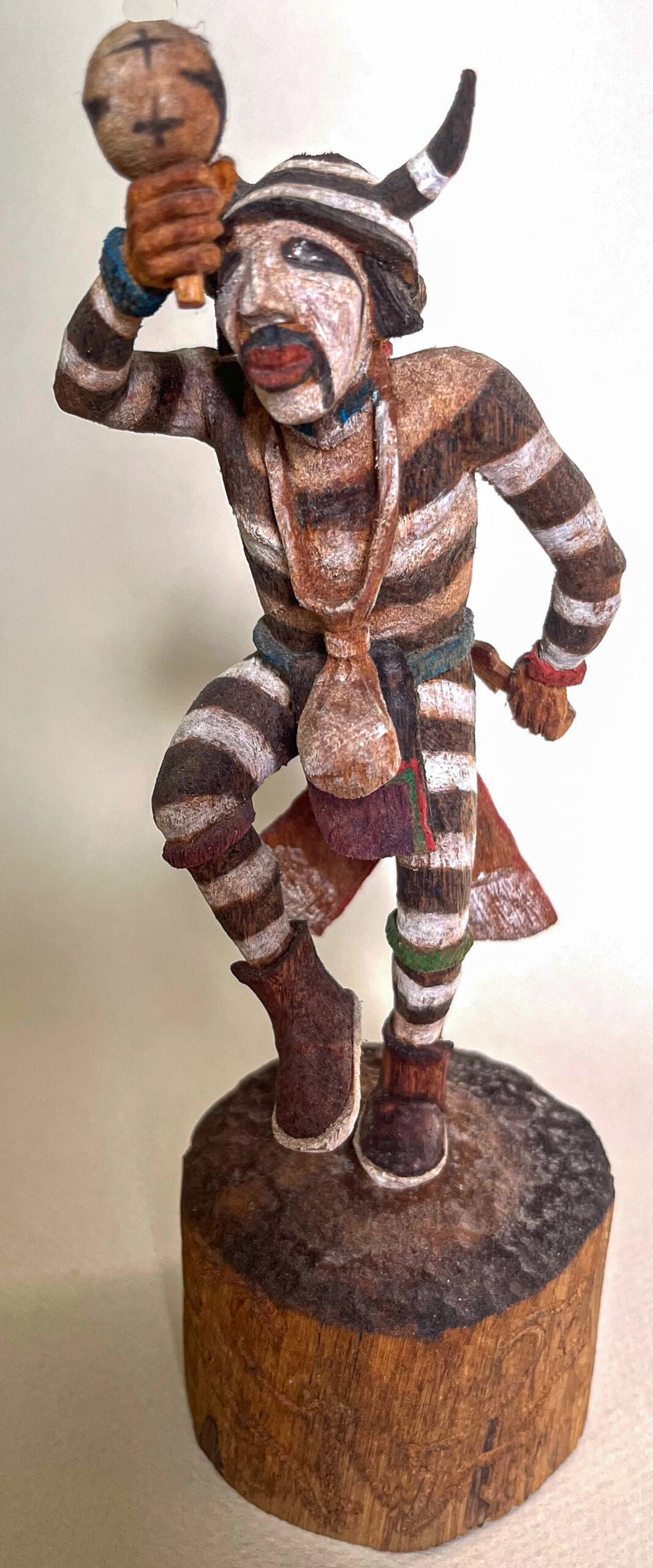 Kachinas are a reminder of a race of people with this particular way of expressing its belief system, just like Australia’s Aboriginal people have a unique way of expression given that they both have an oral tradition. Frank Waters wrote in The Book of the Hopi that the Hopis “regard themselves as the first inhabitants of America. Their village of Oraibi is indisputably the oldest continuously occupied settlement in the United States”. Oh, I haven’t mentioned the Clown Kachinas, but the Clown is ubiquitous in most cultures. Is there a clown in Australian Aboriginal culture; if not, why not?
Kachinas are a reminder of a race of people with this particular way of expressing its belief system, just like Australia’s Aboriginal people have a unique way of expression given that they both have an oral tradition. Frank Waters wrote in The Book of the Hopi that the Hopis “regard themselves as the first inhabitants of America. Their village of Oraibi is indisputably the oldest continuously occupied settlement in the United States”. Oh, I haven’t mentioned the Clown Kachinas, but the Clown is ubiquitous in most cultures. Is there a clown in Australian Aboriginal culture; if not, why not?
Being eclectic does help give meaning to our wonderment of this planet’s diversity. For us, even such a modest Kachina collection is one testament to that.
My first article
In my second year after graduation, I was employed at Geelong Hospital as the Pathology Registrar. Most mornings were consumed with post-mortems and, being a regional hospital, we were entrusted with all the forensic post-mortems as well. Mornings were busy but I learnt the trade and the importance of its role in understanding why a person had died, especially at a time when other forms of post-mortem examination, such as imaging, had yet to be developed. Even now the demise of the regular post-mortem is regretted. Yet it is a casualty of current convention and the fact that in this now multi-cultural Australia, post-mortems are abhorrent and interfere with the burial practices of some religions.
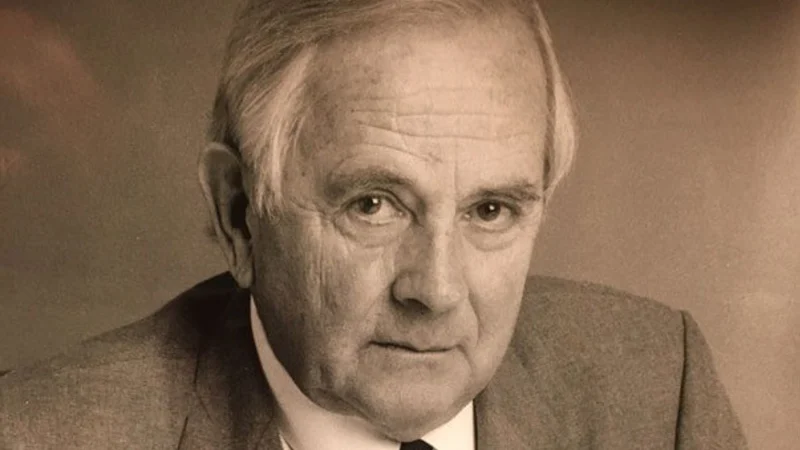
I was fortunate to work under the tutelage of Vern Pleuckhahn, who may not have been the most scholarly pathologist but was certainly the most political, especially in promoting to need to have a first-rate forensic service to assist the Coroner’s office. Even then his pathology service was the best equipped of regional pathology and he was always on the road to Melbourne enlisting support. His deputy, David Buntine was as quietly efficient as his boss was ebullient. Pleuckhahn later achieved his moment of fame in his evidence which was crucial in overturning Lindy Chamberlain’s conviction.
One morning when we opened the chest of a dead young women, it was a sight that even Pleuckhahn had not encountered. Blood was everywhere and overshadowing the heart was this large balloon of blood. The woman had a history of pulmonary hypertension, and it was confirmed as we examined the heart and aorta. There was coarctation of the aorta, which caused it to be narrowed. In other words, instead of being a wide tube, a genetic fault had rendered it such that the blood from the heart, instead of freely flowing, was blocked. At the same time, this woman had a patent ductus arteriosus, a vessel which provides a short circuit for the blood to move directly in foetal life from venous to arterial circulation thus bypassing the lungs, but which normally closes off at birth. The combination of these defects meant that the heart was pumping blood directly into the pulmonary circulation at a far higher pressure than would occur in the normal person.
This had caused her death because the pulmonary artery, which normally takes blood from the right ventricle to the lungs, came under a level of stress for which it was not designed. However, instead of bursting out, the blood had tracked into the artery lining creating a false passage ending in a cul-de-sac, hence the red balloon. It was called a dissecting aneurysm of the pulmonary artery. Dissection of the aorta is a relatively rare cause of death; but dissection of the pulmonary artery? At that time, only eight had ever been reported in the World literature.
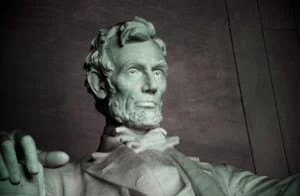 So, with the encouragement of a large number of people, I wrote up this rare case study. I was not a genius; it was others who generously allowed me to be the single author. I tried to find out whether there was incidentally any history of Marfan’s syndrome in her family. In shorthand, if I say Marfan’s syndrome, think of Abraham Lincoln with his tall thin stature, long fingers, high arched palate, problem with the eye lens, and of course, since the syndrome encompasses a suite of connective tissue disorders, the prospect of dissection of the aorta, but not as in this very rare case – dissection of the pulmonary artery.
So, with the encouragement of a large number of people, I wrote up this rare case study. I was not a genius; it was others who generously allowed me to be the single author. I tried to find out whether there was incidentally any history of Marfan’s syndrome in her family. In shorthand, if I say Marfan’s syndrome, think of Abraham Lincoln with his tall thin stature, long fingers, high arched palate, problem with the eye lens, and of course, since the syndrome encompasses a suite of connective tissue disorders, the prospect of dissection of the aorta, but not as in this very rare case – dissection of the pulmonary artery.
Without the post-mortem, it would never have been discovered – but then what does it matter beyond being the subject matter for my first case report-cum-scientific article published in the Medical Journal of Australia in 1966, when I had moved on from Geelong. Nevertheless, I still remember my time in Geelong, and have written about it previously in my blog. Plus, there is something special about your first paper published in this medical journal, which although often dismissed then as the “blue comic” was important to a new graduate searching for a rung on the career ladder.
Keep The Home Fires Burning
I have a deep abiding disgust at the treatment of Prince Harry, a chap clearly still troubled by the loss of his mother. Diana truly loved her sons and yet saddled with a father, so emotionally crippled by the lack of affection he, Charles, received as a child. I know what it is to lose at a young age a mother who was integral to my life and showed her ability to deeply love her son. In contrast, so awkward and unable was a father in trying to provide affection. He tried hard, but he to me was always “Father” never “Dad”. Then he re-married. It was a shock to the system, which only years later I realise how disturbed that action proved to be on my teenage mind. I never got on with my stepmother, who was undoubtedly good for my father in providing the companionship he craved. He too had received an affectionless childhood. But at least my stepmother had not been my father’s mistress while my mother was alive.
I have not led a blameless life, but I believe importantly that I know some of the demons that Harry has faced. His whole mien is that of gentle confusion. Whether he is intellectually bright or not is immaterial, he was born in a world of gilded privilege, and as I have written before within the gilded carriage, stalks evil disguised as beauty. Baudelaire and Rimbaud have alluded to this in their poetry. Therefore, young Harry, once your mother died you were doomed to walk on the “wild side”, no matter what trappings of rank were accorded to you.
But Charles III has been anointed to be the Head of the Anglican Church, the only part of the coronation service which has any meaning to me, as it conveys one of the essential beliefs that maintains my Anglican faith, and that is Apostolic Succession. What is the basis of belief if one does not believe in a discernible line of the head of your Church to Jesus Christ and thence to that other prime Mystery – that of the Trinity. I do not pretend to be a theologian, but my faith depends on how I personally interpret my being an Anglican, and the matter of Apostolic succession. As for myself, I believe firmly in the principles of the Church by reciting the Nicene Creed, which inter alia include the words: “In one holy catholic and apostolic Church; we acknowledge one baptism for the remission of sins; we look for the resurrection of the dead, and the life of the world to come.”
When I saw Prince Harry walking alone down the Abbey aisle amid all the puffed tawdriness of Tradition, I was reminded of what Jesus Christ said, according to the Gospel of St John.
If anyone says, “I love God,” yet hates his brother, he is a liar. For anyone who does not love his brother, whom he has seen, cannot love God, whom he has not seen. And he has given us this command: Whoever loves God must also love his brother.
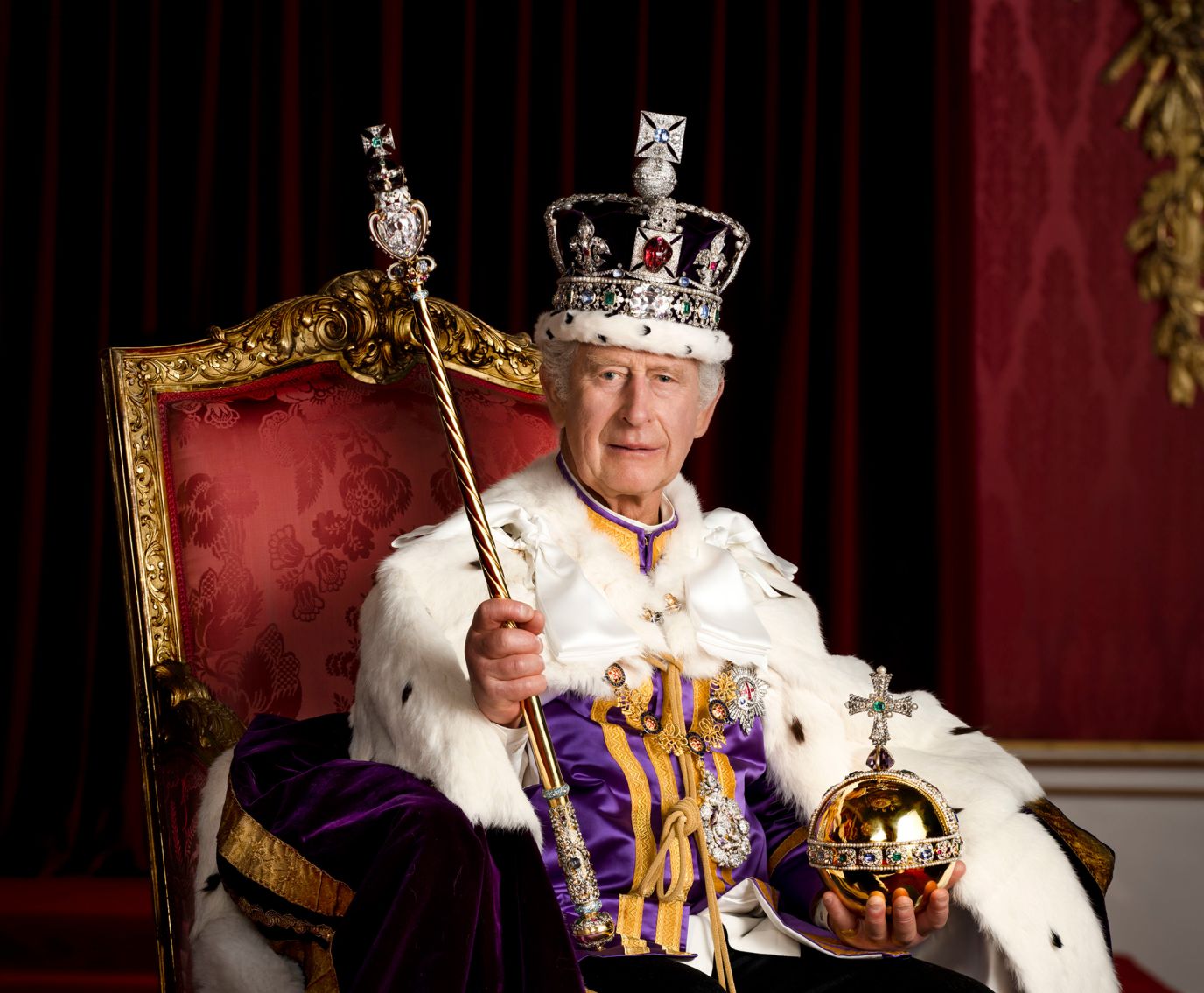 This was the chance of the newly anointed King had to call Harry up to his throne and with William show that he loved his sons equally, and invite the two to embrace and repeat the words of Christ in this regard. This was the chance to show forgiveness, to show his generosity of spirit.
This was the chance of the newly anointed King had to call Harry up to his throne and with William show that he loved his sons equally, and invite the two to embrace and repeat the words of Christ in this regard. This was the chance to show forgiveness, to show his generosity of spirit.
But no; in true Chuck style he flubbed it under the eagle eye of the Camilla Queen, a woman so perfectly cast as the stepmother that I too remember.
Mouse Whisper
Private Eye had a minimalist view on the Coronation last Saturday.
Man in a Hat sits on a Chair.
My response as Murine Laureate for which I get a Furkin of Rye annually as my emolument:
Five Bob
On The Nob
Of this Blob
On the Job
For his Battenberg Mob.

